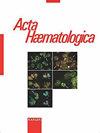费拉替尼治疗对鲁索利替耐药或难治的原发性和后多发性骨髓纤维化或原发性血小板增多症骨髓纤维化患者的疗效:一项全国范围的回顾性研究。
IF 1.7
4区 医学
Q3 HEMATOLOGY
引用次数: 0
摘要
简介 近年来,作为一种选择性 JAK2 抑制剂,非瑞替尼已成为对鲁索利尼治疗失败或不耐受的患者的一种潜在治疗选择。尽管在临床研究中观察到了令人鼓舞的结果,但来自美国和欧洲的实际证据表明,非瑞替尼的疗效可能不那么确定。我们报告了以色列临床实践中鲁索利替尼治疗失败后接受非瑞替尼治疗的骨髓纤维化(MF)患者的特征、治疗模式和临床结果。方法这项回顾性患者病历审查纳入了医生报告诊断为MF的成人患者,他们在停用鲁索利替尼后开始接受非瑞替尼治疗。描述性分析描述了从 MF 诊断到 Ruxolitinib 和 Fedratinib 治疗期间的患者特征、临床结果和治疗模式。约62.5%的患者为女性,中位年龄为77岁(63-85岁)。Ruxolitinib治疗的中位持续时间为17个月(3-84个月)。开始服用非瑞替尼之前,触诊的中位脾脏大小为肋缘下 15.5 厘米(范围为 4-22 厘米)。三个月后,中位脾脏大小为肋缘下 13 厘米(范围为 2-21 厘米)。六个月后,只有两名患者的病情略有好转,三名患者的病情有所进展,两名患者的脾脏大小没有变化。治疗 12 个月后,脾脏反应没有改善。此时,脾脏大小的中位数为肋缘下 19 厘米(范围为 2-30 厘米)。在中耳炎相关症状方面,43.75%(7 人)的患者症状有所改善,37.5%(6 人)的患者症状无变化,而 18.75%(3 人)的患者症状恶化。结论:我们的观察结果表明,在使用鲁索利替尼治疗失败的中风患者中,非瑞替尼的治疗价值可能不大,尤其是在使用鲁索利替尼超过12个月的情况下。我们可以假设,尽早从鲁索利替尼转为服用非瑞替尼可能会取得更好的疗效。本文章由计算机程序翻译,如有差异,请以英文原文为准。
Outcomes of Fedratinib in routine Treatment of ruxolitinib-resistant or refractory patients with Primary and post-polycythemia vera or essential thrombocythemia Myelofibrosis: A nationalwide retrospective study.
INTRODUCTION
In recent years, fedratinib, a selective JAK2 inhibitor, has emerged as a potential therapeutic option for patients who have failed or are intolerant to ruxolitinib. Despite the promising results observed in clinical studies, real-world evidence from the United States and Europe suggests that the efficacy of fedratinib may be less conclusive. We report the characteristics, treatment patterns, and clinical outcomes of patients with myelofibrosis (MF) treated with fedratinib following ruxolitinib failure in Israel's clinical practice.
METHODS
This retrospective patient chart review included adults with a physician-reported diagnosis of MF, who initiated fedratinib after discontinuing ruxolitinib. Descriptive analyses characterized patient characteristics, clinical outcomes, and treatment patterns from MF diagnosis through ruxolitinib and fedratinib treatment.
RESULTS
We extracted data for 16 eligible patients. Approximately 62.5 % of the patients were female, and the median age was 77 (range, 63-85) years. The median duration of ruxolitinib therapy was 17 months (range 3-84 ) months. Before the initiation of fedratinib, the median spleen size by palpation was 15.5cm below the costal margin (range 4-22cm). After three months the median spleen size was 13cm below the costal margin (range 2-21 cm). Only two patients showed minimal improvement after six months, while three patients progressed, and two patients showed no change in the spleen size. The spleen response did not improve after 12 months of treatment. At this point, the median spleen size was 19 cm below the costal margin (range 2-30 cm). Regarding the MF-related symptoms, 43.75% (n =7) of patients reported some improvement, 37.5% (n =6) showed no changes, whereas 18.75% (n =3) of the population complained of worsening. Gastrointestinal toxicity was the most frequent adverse effect of the drug, while 31% of patients died.
CONCLUSION
Our observations showed that in MF patients who have failed to ruxolitinib, the therapeutic value from fedratinib may be modest especially when exposure time to ruxolitinib was more than 12 months. We may hypothesize that earlier switching from ruxolitinib to fedratinib may yield a better result.
求助全文
通过发布文献求助,成功后即可免费获取论文全文。
去求助
来源期刊

Acta Haematologica
医学-血液学
CiteScore
4.90
自引率
0.00%
发文量
61
审稿时长
6-12 weeks
期刊介绍:
''Acta Haematologica'' is a well-established and internationally recognized clinically-oriented journal featuring balanced, wide-ranging coverage of current hematology research. A wealth of information on such problems as anemia, leukemia, lymphoma, multiple myeloma, hereditary disorders, blood coagulation, growth factors, hematopoiesis and differentiation is contained in first-rate basic and clinical papers some of which are accompanied by editorial comments by eminent experts. These are supplemented by short state-of-the-art communications, reviews and correspondence as well as occasional special issues devoted to ‘hot topics’ in hematology. These will keep the practicing hematologist well informed of the new developments in the field.
 求助内容:
求助内容: 应助结果提醒方式:
应助结果提醒方式:


